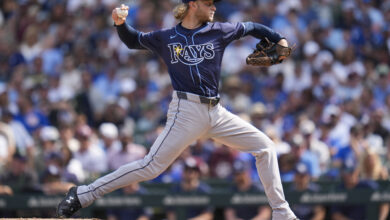Javier Baez Could Go Down in History, One Way or the Other
January can sometimes be no man’s land for a baseball fan. Spring Training is still many weeks away, the winter meetings feel like forever ago, and most of the biggest acquisitions that will happen this offseason have already taken place (save for a Scherzer here or a Shields there).
For the most part we find ourselves wondering about the 2015 season, which is shaping to be the most interesting for the Cubs in the last several years. We known the common storylines: the looming bat of Kris Bryant, the new faces of Jon Lester, Miguel Montero, David Ross, and others, or Year One of Joe Maddon.
It’s easy to forget that a year ago, Javier Baez was THE guy people were gushing over. The effusive praise from Jason Parks has almost become Cubs folklore, and you’d be hard pressed to find a Top 10 list that didn’t have him positioned as the top prospect in the organization. Of course, we know what happened.
After hitting a few “Oh my God” home runs in his first few games, Baez came crashing down to the earth and his at-bats went from exhilarating to uncomfortable. He ended the season with a wOBA of .248 and a wRC+ of…wait for it…51. I’ve spent some of this offseason trying to find numbers that make me go “Wait, he was good in that area!” but it’s been a futile endeavor.
The thing is, we expected this. Maybe not that many strikeouts and looking overmatched as often as he was, but at every new level Baez has come out struggling before finding his form. In 2014 at Iowa, his OPS rose every month until his major league debut. The same happened in 2013, when he was promoted from Daytona to Tennessee. Failures first, followed by an impressive adjustment.
Baez’s time in Chicago was ugly and though previous patterns are encouraging, they don’t guarantee anything. He has to prove it all over again, showing he not only belongs, but can reach the ceiling we all hope for. What’s discouraging is trying to find a player who looked so bad at the major league level when he debuted and still found stardom.
But since it’s January and we need stuff to talk about, let’s try anyway.
Gary Sheffield is the most common comp for Baez, mainly because of the stance and bat speed.What’s sobering about this is that Sheffield played in his first big league game at the age of 19, and outperformed Baez despite being two years younger. In fact, over the course of almost 500 plate appearances before the age of 21, Sheffield wasn’t nearly as bad as Baez. He wasn’t good, mind you, but by comparison his below average-ness looks downright acceptable.
At age 21, Sheffield had a breakout season, good for 2.9 fWAR and a wRC+ of 118. That’s not superstar production, but thrilling to get out of a player that young. The next season, he had injury problems and conflicts with the organization, appearing in only 50 games and regressing offensively. But after a change of scenery at age 23, Sheffield became the hellacious force we pray Baez might be.
It’s hard to envision Baez hitting for an average of .330 or walking as much as Sheffield, but the power output could be even greater and his value at a middle infield position would mitigate some of his flaws. Either way, trying to predict a career trajectory like Sheffield’s is foolish and discouraging, so let’s try something else.
Just take a few stats from Baez’s 2014* and see what kind of company he’s in (click chart to enlarge).
That’s not a very fun list, except for Danny Ainge. Also consider that no other player has ever struck out in 40% of their plate appearances (min. of 225 PA) over the course of a season. Baez stands alone in that dubious category.
The good news, of course, is that Baez is blessed with rare raw talent and will be guided by one of the best managers in the game. He’s one of the youngest players in baseball and will be surrounded by more polished hitters to relieve some of the pressure. He was historically bad, but with all of that power in a shortstop’s body, he could be historically good.
*Via the Baseball Reference Play Index


